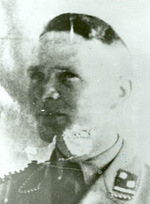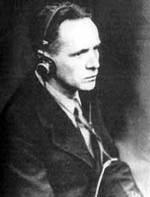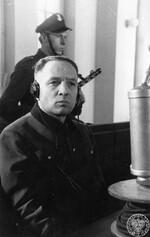Rudolf Höss
| Surname | Höss |
| Given Name | Rudolf |
| Born | 25 Nov 1900 |
| Died | 16 Apr 1947 |
| Country | Germany |
| Category | Government |
| Gender | Male |
Contributor: C. Peter Chen
ww2dbaseRudolf Franz Ferdinand Höss was born in Baden-Baden, Germany into a strict Catholic family. His father, an army veteran who had served in German East Africa, ran a tea and coffee business. His father had decided early on that Rudolf Höss would enter priesthood, but he rebelled against religion during his later teenage years (he would later renounce his Catholicism in 1922) and joined the military. During WW1, he served briefly in a military hospital and then was assigned to the 21st Regiment of Dragoons in 1914. He fought in the Ottoman Empire and by 1917 he had become the youngest non-commissioned officer in the German Army. When WW1 ended, he was in the Ottoman Empire. He disobeyed his orders to lay down arms; instead, refusing to become a prisoner of war, he led his troops on a three-month march across southeastern Europe, engaging in several firefights against Allied forces and vigilantes. He won the Iron Cross first and second class medals for his actions during WW1.
ww2dbaseWhen Höss returned home, he received a small inheritance that was specified for his seminary education. Still skeptical of Catholicism, he rejected this money and instead completed a non-religious secondary education then joined the German Freikorps movement (initially East Prussian Volunteer Corps, then Freikorps Rossbach). In the 1920s, he had participated in guerrilla attacks against French occupation forces in the Ruhr region as well as against Polish forces in the Silesia region. He joined the Nazi Party as member number 3,240 after hearing Adolf Hitler speak in Munich, Germany. On 31 May 1923, he was one of the few Nazi Party members responsible for carrying out the orders of Martin Bormann to kill by beating the suspected communist spy Walther Kadow to death in Mecklenburg in northern Germany; this action was carried out as a revenge for the recent arrest and execution of Nazi saboteur Albert Leo Schlageter. For this killing, he was arrested as the leader of this murder; on 15 May 1924, he was sentenced to 10 years in prison while Bormann received a one-year sentence. He was released in Jul 1928 as the result of a general amnesty. On 17 Aug 1929, he married Hedwig Hensel, with whom he would have two sons (Klaus in 1930 and Hans-Rudolf Jürgen in 1937) and three daughters (Heidetraut in 1932, Ingebrigitt in 1933, and Annegret in 1943). The two became involved in the nationalistic movement involving the Blut und Boden ("Blood and Soil") ideology and worked on a farm in northern Germany.
ww2dbaseIn 1934, Höss joined the SS organization of the Nazi Party. Initially, he was supposed to raise horses for the growing SS para-military forces, but after meeting with Heinrich Himmler, an old acquaintence from the early 1920s, he was convinced to transfer to the newly established branch of the SS that operated concentration camps. Later in 1934, he became a member of SS-Totenkopfverbände (Death's Head Units). In Dec 1934 he was assigned to Dachau Concentration Camp as a Blockführer; at this time, Dachau already had a prisoner population of about 4,800. His family soon joined him at Dachau, living in officers' quarters. His autobiography stated that, during his time at Dachau, witnessing and carrying out the brutality of the treatment of prisoners, he felt some regret for leaving the religious career that his parents planned for him. In 1938, he was promoted to the rank of SS-Hauptsturmführer and was made the adjutant of Hermann Baranowski of Sachsenhausen Concentration Camp. In 1939, he became a member of the Waffen-SS.
ww2dbaseOn 1 May 1940, Höss was made the first commandant of Auschwitz Concentration Camp and all of its sub-camps in Poland. In Jun 1941, he traveled to Berlin, Germany and met with SS leader Heinrich Himmler, who gave him a secret order to begin exterminating Jew at Auschwitz; he later admitted that he did leak this secret order to one person in late 1942, his wife. After studying methods of extermination that were already in place at Treblinka Concentration Camp, he implemented his own methods of extermination which would prove to be more efficient. Among other things, he had developed the methodology of sending unfit-for-work prisoners directly to the gas chambers immediately upon arrival; the disguise of gassing chambers as shower rooms was also accredited to him. He held command of Auschwitz until 30 Nov 1943; in the three and a half years at the helm of the concentration camp system, more than a million people were killed. On 1 Dec 1943, he became the head of Amt D I in Amtsgruppe D (in charge of concentration camps) of the SS-Wirtschafts-Verwaltungshauptamt (Main SS Economic and Administrative Department), with his office located at the Sachsenhausen Concentration Camp in Oranienburg, Germany. On 8 May 1944, he returned to Auschwitz to supervise an operation known as Aktion Höss, during which 430,000 Hungarian Jews were killed over a period of 56 days.
ww2dbaseIn the final days of the war, Höss was advised by Himmler to disguise himself among German Navy personnel. Taking his advice, Höss was given the identity papers of Franz Lang, a German Navy sailor who had recently been killed in action. He spent the following four weeks at a naval school, then he traveled with his family to the Flensburg region of northern Germany to work on the farm owned by Hans Peter Hansen. During this time, he stayed at the farm while his wife and children lived in a small apartment above a nearby sugar factory. British Army Captain Hanns Alexander, a German Jewish refugee who had evacuated to Britain prior to the war, was temporarily assigned to a unit charged with finding and capturing accused war criminals. With dedication and luck, Alexander found Hedwig Hensel Höss, and kept her in captivity. As he repeatedly failed to persuade her to reveal Rudolf Höss' location, Alexander arrested their oldest son Klaus as means to wear down Hedwig Hensel Höss. On 11 Mar 1946, hearing a train slowing and stopping near the prison, Alexander bluffed by noting that the train had arrived to pick up war criminals for a labor camp in Siberia, Russia, and if they did not reveal Rudolf Höss' location, Klaus would be sent on that train. Alexander left her a piece of paper and walked out of the cell. When Alexander returned ten minutes later, the address of the Hansen farm had been written on the paper. Alexander immediately led a group of British soldiers to the farm, arriving after sundown. Initially, Höss insisted that he was Franz Lang and not the accused war criminal Alexander was seeking, but Höss' identity was betrayed by his wedding ring, which had "Rudolf and Hedwig" inscribed on the inside. A number of Alexander's men were Jews, and Alexander turned the other way while they roughed up Höss for ten minutes. Four days later, in a written statement, he confessed that he was indeed Rudolf Höss, and he supervised the murder of countless Jews at Auschwitz.
ww2dbaseDuring the Nuremberg Trials, US prosecutor Whitney Harris used Höss as a witness against Ernst Kaltenbrunner, Oswald Pohl, and the I. G. Farben Corporation. On 25 May 1946, he was handed over to Polish authorities. The Polish Supreme National Tribunal would later put him on trial for the murder of Polish people. He was accused of murdering 3,500,000 people, but, upon hearing this charge, he commented that the count had only been 2,500,000; the remaining 1,000,000 died of disease and starvation, to which he refused responsibility. He was sentenced to death on 2 Apr 1947. He completed his autobiography while awaiting his execution; it was published in 1958 under the title of Kommandant in Auschwitz; autobiographische Aufzeichnungen in German and later in English as Death Dealer: The Memoirs of the SS Kommandant at Auschwitz. On 10 Apr 1947, he sent a message to the state prosecutor who had worked against him during his trial; part of the message read:
ww2dbaseHöss was executed by hanging on 16 Apr 1947 next to the crematorium of Auschwitz I concentration camp; a medical doctor pronounced him dead at 1021 hours. He had initially protested against hanging, as he felt it was unfit for a military serviceman. President of communist Poland Boleslaw Bierut rejected Höss' request for an alternative method of execution. After his death, he was buried in a unmarked grave nearby.
ww2dbaseSources:
Thomas Harding, Hanns and Rudolf
Wikipedia
Last Major Revision: Nov 2010
Rudolf Höss Interactive Map
Photographs
 |  |  |  |
Rudolf Höss Timeline
| 25 Nov 1900 | Rudolf Höss was born in Baden-Baden, Germany. |
| 31 May 1923 | Rudolf Höss and a group of Nazi Party members killed suspected communist Walther Kadow in Mecklenburg, Germany to avenge the death of fellow party member Albert Leo Schlageter. |
| 15 May 1924 | Rudolf Höss received a 10-year sentence for the murder of Walther Kadow. |
| 17 Aug 1929 | Rudolf Höss married Hedwig Hensel. |
| 6 Feb 1930 | Rudolf Höss' eldest child Claus was born. |
| 9 Apr 1932 | Rudolf Höss' second child Heidetraut was born. |
| 18 Aug 1933 | Rudolf Höss' third child Ingebrigitt was born. |
| 20 Sep 1933 | Rudolf Höss applied for a transfer into the SS organization and was given the rank of a SS recruit, SS-Anwärter. |
| 20 Sep 1933 | Rudolf Höss applied to join the Nazi SS organization. |
| 1 Apr 1934 | Rudolf Höss was accepted into the SS organization and was given the rank of SS-Mann. |
| 20 Apr 1934 | Rudolf Höss was promoted to the rank of SS-Sturmmann. |
| 11 Jun 1934 | Rudolf Höss participated in a new SS members' gathering and inspection at Stettin, Germany (now Szczecin, Poland). He met with Heinrich Himmler, an old passing acquaintance, who asked him to transfer from his original task of raising horses for the SS to a new position in the concentration camps system. |
| 28 Nov 1934 | Rudolf Höss was promoted to the rank of SS-Unterscharführer. |
| 1 Dec 1934 | Rudolf Höss arrived in München (Munich), Germany and would soon depart for his new posting at Dachau Concentration Camp. |
| 1 Apr 1935 | Rudolf Höss was promoted to the rank of SS-Scharführer. |
| 1 Jul 1935 | Rudolf Höss was promoted to the rank of SS-Oberscharführer. |
| 1 Mar 1936 | Rudolf Höss was promoted to the rank of SS-Hauptscharführer. |
| 13 Sep 1936 | Rudolf Höss was promoted to the rank of SS-Untersturmführer. |
| 1 May 1937 | Rudolf Höss' fourth child Hans-Rudolf Jürgen was born. |
| 11 Sep 1938 | Rudolf Höss was promoted to the rank of SS-Obersturmführer. |
| 9 Nov 1938 | Rudolf Höss was promoted to the rank of SS-Hauptsturmführer. |
| 1 May 1940 | Rudolf Höss was appointed the first Commandant of Auschwitz Concentration Camp in German-occupied Poland. |
| 19 Dec 1940 | Archbishop Sapieha of Krakow, Poland sent a letter to Auschwitz Commandant Rudolf Höss requesting permission for Christmas mass to be held in the camp for Catholic prisoners. Höss turned down the request because the camp rules did not permit religious observations, but did agree that approximately 6,000 one-kilogram food parcels could be sent to all the prisoners over the holidays. |
| 30 Jan 1941 | Rudolf Höss was promoted to the rank of SS-Sturmbannführer. |
| 1 Mar 1941 | Rudolf Höss and his family hosted Heinrich Himmler for dinner during Himmler's inspection of Auschwitz Concentration Camp in occupied Poland. |
| 18 Jul 1942 | Rudolf Höss was promoted to the rank of SS-Obersturmbannführer. |
| 30 Sep 1942 | Commandant of Auschwitz Concentration Camp Rudolf Höss forbade his SS guards to consume raw fruits, raw vegetables, and raw milk due to the typhus epidemic in the camp. |
| 14 Feb 1943 | Commandant Rudolf Höss of the Auschwitz Concentration Camp issued Garrison Order No. 3 which instructed the SS guards to "maintain an appropriate distance from the prisoners" to order to prevent the spread of typhus which was rampant among the prisoners. |
| 2 Mar 1943 | At 2140 hours, Auschwitz Concentration Camp commandant Rudolf Höss was informed that 15,000 Berlin Jews were being transported to the camp; he ordered that the prisoners must be kept in good health during the journey so that they could work at Auschwitz. |
| 20 Sep 1943 | Rudolf Höss' fifth child Annegret was born. |
| 30 Nov 1943 | Rudolf Höss served his final day as the commandant of Auschwitz Concentration Camp in occupied Poland. |
| 1 Dec 1943 | Rudolf Höss was assigned to the SS-Wirtschafts-Verwaltungshauptamt based at the Sachsenhausen Concentration Camp in Oranienburg, Germany. |
| 6 May 1944 | Rudolf Höss received orders to travel to Auschwitz Concentration Camp in occupied Poland. |
| 8 May 1944 | Rudolf Höss returned to Auschwitz Concentration Camp to supervise Aktion Höss, the extermination of 430,000 Hugarian Jews. |
| 9 May 1944 | Rudolf Höss returned to Auschwitz Concentration Camp and ordered the expansion of the rail platforms, the activation of Crematorium V, the reactivation of Bunker 2 (gas chamber), the digging of five pits, among other items, in preparation for the arrival of Hungarian Jews at Auschwitz. |
| 11 Mar 1946 | Rudolf Höss, who had been living for the past year as a farmer under the pseudonym Franz Lang, was arrested by British troops. |
| 15 Mar 1946 | At Camp Tomato in Minden, Germany, Rudolf Höss confessed to having supervised the murder of countless Jews at Auschwitz Concentration Camp in occupied Poland. |
| 30 Mar 1946 | British authorities at Camp Tomato in Minden, Germany received US prosecutor Whitney Harris' cable requesting the transfer of Rudolf Höss to Nürnberg (Nuremberg), Germany to serve as a witness against other accused war criminals. |
| 31 Mar 1946 | Rudolf Höss departed Minden, Germany for Nürnberg (Nuremberg), Germany. |
| 25 May 1946 | Rudolf Höss was driven to the airport of Nürnberg (Nuremberg), Germany and was placed on a US aircraft for his transfer to Polish authorities at Warsaw, Poland. |
| 30 Jul 1946 | Rudolf Höss was transferred from Warsaw, Poland to Kraków, Poland. |
| 11 Mar 1947 | The trial against Rudolf Höss at the Supreme National Tribunal of Poland began. |
| 27 Mar 1947 | The trial against Rudolf Höss at the Supreme National Tribunal of Poland ended with a guilty verdict. |
| 2 Apr 1947 | Rudolf Höss was sentenced to death by Polish authorities. |
| 10 Apr 1947 | Rudolf Höss wrote a letter to the state prosecutor who had worked against him during his trial, noting that he realized he had sinned and was ready to receive the punishment of death. |
| 11 Apr 1947 | Rudolf Höss wrote the last letters to his wife and children from his prison cell in Poland. |
| 16 Apr 1947 | Rudolf Höss was executed by hanging next to the crematorium of Auschwitz I concentration camp. He was pronounced dead at 1021 hours by a medical doctor. He was then buried in a unmarked grave nearby. |
Did you enjoy this article or find this article helpful? If so, please consider supporting us on Patreon. Even $1 per month will go a long way! Thank you. Share this article with your friends: Stay updated with WW2DB: |
Visitor Submitted Comments
1 Aug 2011 07:05:46 PM
Above photograph, is not that of Rudolf Hess
Deputy Fuhrer, and the third most powerful man in Nazi Germany. Got your Rudolf's mixed
up, But that of Rudolf Hoss please read above information.
27 Apr 2015 06:28:50 AM
no, Asrael you're stupid. They're two different guys
All visitor submitted comments are opinions of those making the submissions and do not reflect views of WW2DB.
» Discovery of Concentration Camps and the Holocaust
» Nuremberg Trials and Other Trials Against Germany
Related Books:
» Hanns and Rudolf
- » 1,146 biographies
- » 336 events
- » 43,422 timeline entries
- » 1,237 ships
- » 349 aircraft models
- » 207 vehicle models
- » 372 weapon models
- » 123 historical documents
- » 259 facilities
- » 468 book reviews
- » 28,395 photos
- » 432 maps
Winston Churchill
Please consider supporting us on Patreon. Even $1 a month will go a long way. Thank you!
Or, please support us by purchasing some WW2DB merchandise at TeeSpring, Thank you!
30 Mar 2011 01:07:43 AM
The NAme from this man was rudolf Hess not Höss